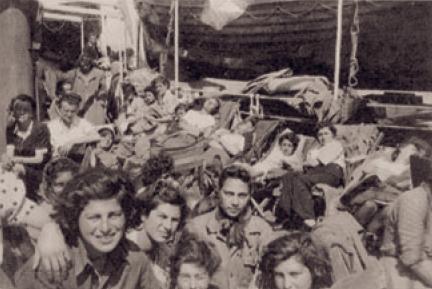Life after Survival
Recuperating after Liberation
Many survivors spent the first weeks and months after their liberation in camps for “Displaced Persons” (DPs). The sick were treated in military hospitals and sanatoriums in Hamburg and Schleswig-Holstein. Many suffered from contagious diseases and were placed under quarantine. Former political prisoners from Neuengamme concentration camp set up sanatoriums in the vicinity of Hamburg and helped survivors in their search for relatives.Despite the care they received immediately after their liberation, many survivors would suffer from the long-term physical and psychological effects of their imprisonment for the rest of their lives.
Repatriation and Emigration
During the war, more than 10 million people from outside Germany were forced to work in the German war economy. After the liberation, the Allies faced the problem of having to organise the repatriation of these former slave laborers and the liberated concentration camp prisoners. Some of the DP camps therefore had to remain in operation for several years. Out of fear of repression, many of the deportees from Eastern Europe did not return to their countries of origin voluntarily. But in Western Europe too, not all returning survivors received a warm welcome from their compatriots. Many survivors, especially the Jewish one, decided to emigrate to Palestine (later Israel), Canada or the USA, but they often had to wait for years before they received their visa.

Survivors on board of the “Kronprinsessan Ingrid”, a ferry chartered by the Swedish Red Cross. Taken in May 1945. Many survivors were brought to Sweden to recuperate and were taken care of there by the Swedish Red Cross. They were often still dressed in their prisoners’ uniforms and were sick and weak when they arrived in Sweden on the ferry. Many recovered at least physically from their imprisonment and left the country again to return home, while others decided to remain in Sweden.
Reparatation
German survivors who could prove that they had suffered political, racial or religious persecution received different forms of compensation in different parts of Germany. In 1953, the government of the Federal Republic of Germany passed alaw which set binding standards for compensation payments, although non-German survivors and former slave labourers were still excluded. The Federal Republic signed agreements on reparations with Israel and several Western states, but survivors from Eastern Europe and, during the Cold War, some Germans who had been persecuted for their Communist beliefs continued to be denied reparations for a long time.The reparation policies of the German Democratic Republic differentiated between “Antifascist Resistance Fighters” and “Victims of Fascism”, and the groups received different payments. There, too, entire groups of victims were ignored. In August 2000, the “Remembrance, Responsibility and Future” foundation started its work, but by then it was too late for most of the survivors.